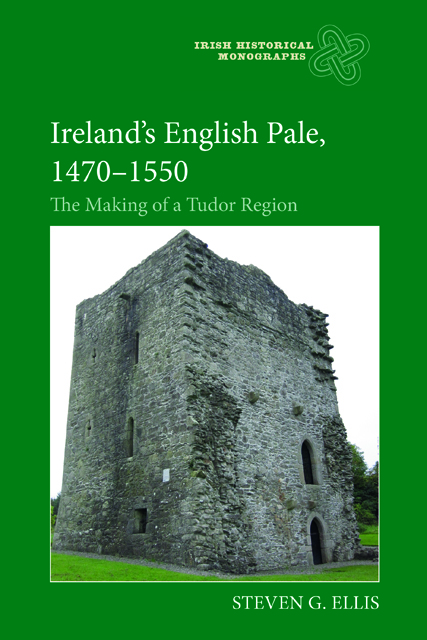Book contents
- Frontmatter
- Contents
- List of Maps
- Preface
- List of Abbreviations
- Introduction: in search of Ireland's English Pale
- 1 The horizons of English rule: retreat and recovery
- 2 The fortifications and identity of a military frontier
- 3 County Dublin and the military frontier
- 4 Strengthening the march in County Kildare
- 5 The English Pale's westward expansion: County Meath
- 6 The English Pale's northern frontier: County Louth
- 7 Restoring the English Pale, 1534-41
- 8 The waning of the English Pale
- Conclusion: an English region in Tudor Ireland
- Bibliography
- Index
- Irish Historical Monographs previous volumes
5 - The English Pale's westward expansion: County Meath
Published online by Cambridge University Press: 09 January 2024
- Frontmatter
- Contents
- List of Maps
- Preface
- List of Abbreviations
- Introduction: in search of Ireland's English Pale
- 1 The horizons of English rule: retreat and recovery
- 2 The fortifications and identity of a military frontier
- 3 County Dublin and the military frontier
- 4 Strengthening the march in County Kildare
- 5 The English Pale's westward expansion: County Meath
- 6 The English Pale's northern frontier: County Louth
- 7 Restoring the English Pale, 1534-41
- 8 The waning of the English Pale
- Conclusion: an English region in Tudor Ireland
- Bibliography
- Index
- Irish Historical Monographs previous volumes
Summary
Early Tudor Meath was a relatively large county, extending westwards from the coast near Drogheda almost to the banks of the River Shannon, and encompassing a much larger area of the English Pale than any other shire. It lay in one of the most heavily feudalized regions of Ireland, with large numbers of minor tenants-in-chief, 76 of them in 1430, many holding quite small parcels of land by knight service. These formed the basis of early Tudor Meath’s vigorous county community. The county’s large size, however, also reflected in part the earlier inclusion within its boundaries of the extensive feudal liberty of Trim, covering half the geographical area of Meath and interposed between the main portion of the royal county in the north-east, with its county town of Kells, and the separate western marches extending out towards Athlone. This administrative division between the liberty and two separate sections of the royal shire had previously complicated local government in the shire: it was one reason why, among the English surnames of the far west, the Daltons, Dillons, Tyrrells, and Delamares, English administration had gradually collapsed from the late fourteenth century. Elsewhere across the four shires, the early Tudor Pale’s expansion had also included the restoration of English local government among so-called ‘English rebels’, the Harrolds and Walshmen in south Dublin, the Berminghams in Carbury. In Meath, however, the restoration of English rule and control over the English lineages of the far west was a more sweeping, thorough going aspect of the early Tudor Pale’s expansion than the very visible, but piecemeal, seizure and recovery of marchlands from Irish border chiefs. The result was that the shire’s defence was less reliant on a coordinated system of tower houses and earthworks along a clearly defined military frontier, such as that south of Dublin, but rather relied chiefly on an extended march. This took the form of defence in depth across a more sparsely populated, predominantly pastoral landscape, with a lineage society living in defended settlements with few towns, but screening the more densely populated mixed farming districts of nucleated villages and market towns further east.
Latterly, Trim had been held by Richard duke of York with palatine powers, but in 1479 King Edward IV eventually ordered the liberty suppressed, after he had acquired Duke Richard’s rights as his heir and successor, following his accession to the throne.
- Type
- Chapter
- Information
- Ireland's English Pale, 1470-1550The Making of a Tudor Region, pp. 100 - 124Publisher: Boydell & BrewerPrint publication year: 2021



